The GI tag indicates that the product possesses qualities unique to the area and its artisans.
India is plush with many different art forms that depict the country’rich heritage ,thanks to its centuries old history and culture.
But in a competitive market, it gets difficult for buyers to ensure the products they buy are original and sourced from the place of origin.
A geographical indication tag is applied to products native to a particular place, such as artworks, handicrafts, paintings, food and other souvenirs in order to signify quality and authenticity.
The tag ensures that only people belonging to the specific geographical area in which the art originated or grew popular can use the product name for sales purpose.
The first Indian product to be GI tagged was Darjeeling tea in 2003. Since then, the list has only grown longer encompassing India’s ancient arts and traditions.
The artforms in India that have been bestowed with this title are listed below.
10 GI Tagged Art Forms Of India:
1. Rogan Paintings
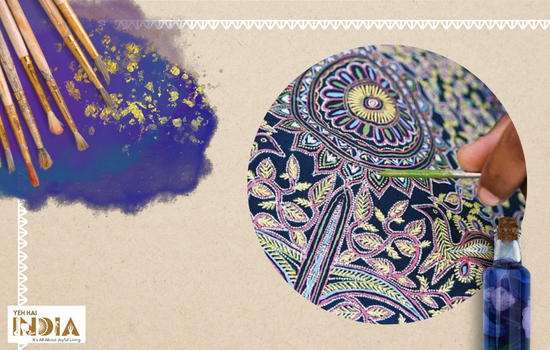
A 400 year old art form that flourished at Nirona Village in Kutch, Gujarat, Rogan Paintings utilise a unique castor based paste which is then combined with coloured powder in order to create paint meant for textiles.
Castor seeds are pounded in order to create the oil which is then boiled in order to create a paste.
One half of the fabric is painted with a flat iron rod, known as kalam, and the other half is folded over and pressed to the first half in order to create a symmetrical design.
Rogan art was initially used to design the bridal wear of the community. Although demand for the art has declined due to the rise of machine made textiles, the Abdul Gafar family keeps this tradition alive even today.
2. Sohrai Kovar Paintings

Sohrai Kovar paintings are a form of the the earliest art made by man: paintings created on the walls of dwellings using coloured soil as paint.
It hails from the Hazaribagh district of Jharkhand although now it can be seen in other places of significance such as the Birsa Munda Airport in Ranchi and the Tatanagar Railway Station.
It is a tribal art form practised by women during the local harvests and wedding seasons.
They use naturally and locally occurring coloured soil in order to create murals traditionally on the walls of mud houses although now they can be seen on other surfaces as well. The pattern is dominated by dots, lines, plant and animal forms.
Recommended Story – Gond Art: Showcasing The Folk Heritage Of Gond Tribe
3. Kangra Paintings
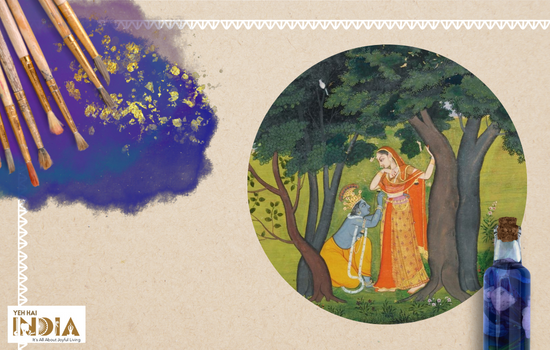
Kangra Paintings are named after the Kangra kingdom, a former princely state from Himachal Pradesh which primarily patronized the art form.
It emerged in the mid-18th century and had such a large impact on the artisans of the time that the Pahari painting school was renamed the Kangra painting school.
The main feature of Kangra paintings is the prominently displayed natural setting. Great care is taken to show verdant scenes with striking attention to detail and variety.
The painters use colours made out of mineral extracts and vegetables and often prefer shades of the primary colours themselves.
4. Kalamkari Paintings
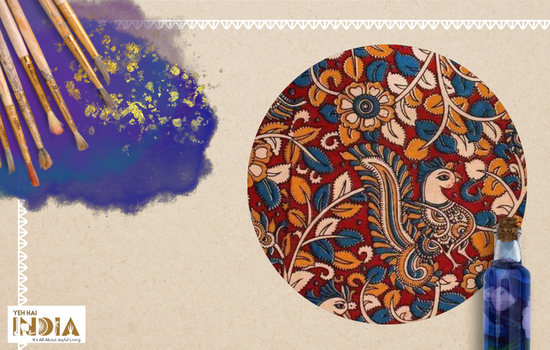
Kalamkari Painting refers to the intricate hand-painting of cloth in a style that originated somewhere in the states of Andhra Pradesh and Telangana.
This style was the first to picturize scenes from Mahabharata and the Ramayana as these paintings were frequently used as decorative pictures of Gods in temples.
Even today, Kalamkari paintings mainly feature devotional scenes. A popular image is that of the Tree of Life which unites heaven, earth and hell.
Many creatures live along its branches and eat its fruit and hence, it sustains life. Animals like tigers, deers, and peacocks are popular motifs in this artform.
5. Warli Paintings
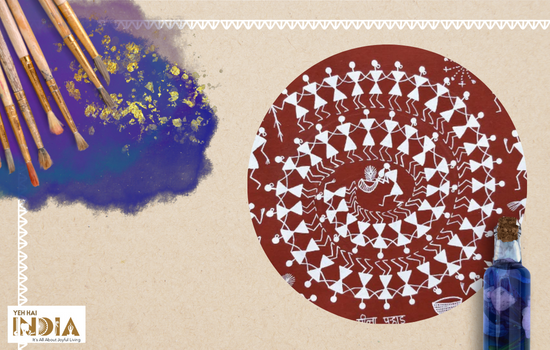
Warli painting originated in the North Sahyadri Range of Maharashtra and is one of the earliest schools of drawing in history.
They depict the everyday life events of the people of the Warli tribe and their social events like weddings. Warli paintings make excellent use of geometric shapes.
The circles in Warli paintings represent the sun and the moon, whereas the triangles represent mountains and trees.
The squares are generally used for human figures and is usually the central motif of a particular art piece. The paint used is a white pigment made from rice flour and water with gum as a binding agent.
6. Cheriyal Scroll Paintings
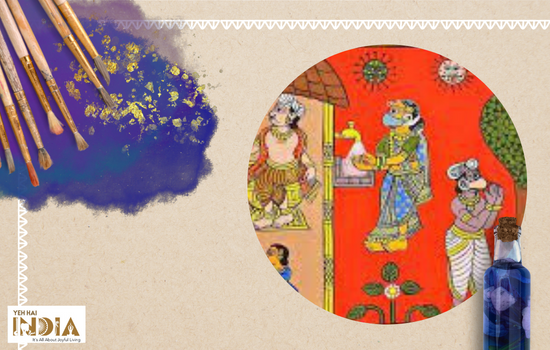
Cheriyal scroll paintings are a derivative of nakashi art. It originates in Hyderabad and generally features a host of motifs specific to the region. They are painted in a narrative style and depict stories from Indian mythology.
Therefore, the paintings are inseparable from the art of story telling and their displays were often accompanied by song and dance.
These paintings are not confined to the strict classical notions of the Thanjavur and Mysore paintings and therefore, more prone to artistic flairs and flights of fancy.
They predominantly feature a red background and are painted in primary colours onto a cotton Khadi canvas with brushes made of squirrel hair.
7. Madhubani Paintings
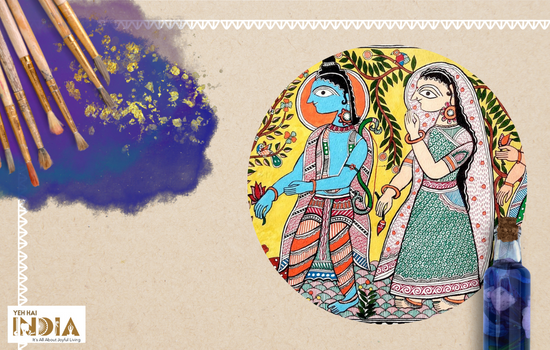
Madhubani paintings are popularly found in the Mithila region of India. The paintings are known for their unique geometrical designs that visualize particular occasions such as birth, marriage or various festivals.
The paintings were originally created on the freshly plastered walls and floors of huts.
The paintings may also depict the relationship humans share with nature and scenes from ancient mythology. It has five distinctive styles namely Bharni, Katchni, Tantrik, Godna and Kohbar.
Bharni and Tantrik styles were initially mainly painted by Brahmin women but these days, the caste distinctions have mostly eroded.
8. Thanjavur Paintings
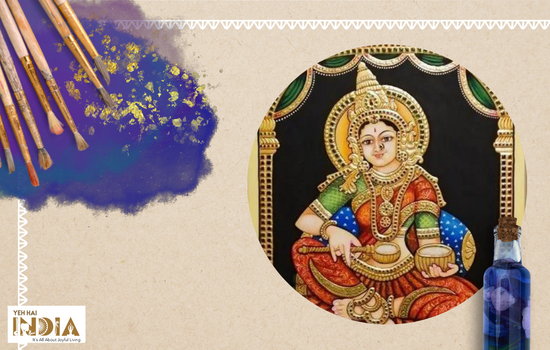
Thanjavur paintings are a form of classical South Indian paintings that thrived under the golden reign of the Vijayanagar Empire which patronized art and other forms of expression.
However, they show evidence of influence from various powers that gained prominence in India over the years including the Deccan Shahi, Maratha and European powers.
Thanjavur paintings can be recognized by their famous gold coating. They often feature rich and vivid colouring, simple composition and the inlay of glass pearls or, in some cases, precious gems.
The paintings serve mainly as devotional objects and feature Hindu deities and saints.
9. Mysore Traditional Paintings
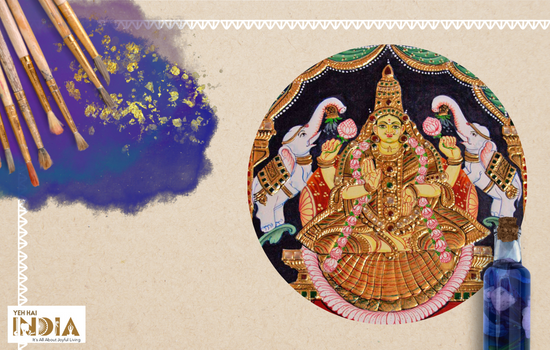
Mysore paintings flourished in the area due to the rich patronage of the rulers of Mysore.This particular style of painting also emerged under the illustrious Vijayanagar empire.
Mysore paintings tend towards muted colours, elegance, and deep attention to detail. They were meant to be more than just decorative pieces and were supposed to evoke deep emotion in the viewer.
Although the painting instruments in Mysore paintings were similar to the other contemporary art forms of the time, the painters in Mysore developed special brushes made out of pointed blades to depict a variety of grass.
10. Gujarat Pithora Paintings

Pithora Art is created in order to seek the blessings of the Pithora Devi, popularly worshipped in Gujarat. It is believed that doing so will lead her to appease the creator.
Therefore, Pithora paintings are more than an art form. They are considered more of a ritual that is performed in order to either seek blessings or thank the deity.
The painting generally contains elements of the mythology of the tribe as well as the horses of the Gods and Goddesses and the ancestors of that particular tribe. Daily human activities such as trade and farming are also given representation.
India is a highly diverse nation with many different art forms flourishing in its lands. It is our responsibility to be conscious of these art forms, to encourage them and to help them thrive.
It is important to pass on these cultural traditions to the next generation so that India’s continued legacy may always be rich.
These paintings foretell the varied lifestyles and interests of people living in different places in the yesteryears.
It is indeed a moment of pride for the artisans to get their works stamped with the Geographical Indication tag, so the buyers can safely purchase their works of art without any chances of grabbing a duplicate artwork.
Also Read – Kathakali: A Flamboyant Folk Art Of Kerala










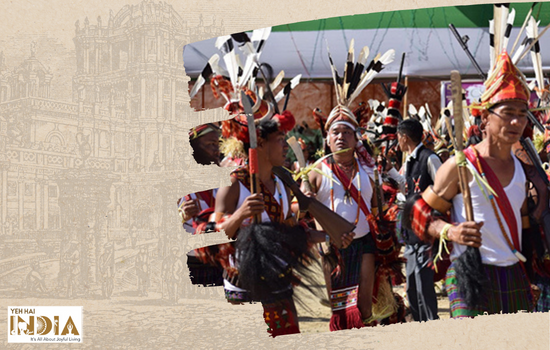
Thank a lot for this article.Thanks for sharing this valuable information here.I will find one of the best information here.really it’s useful for me
I have been using this was very useful.